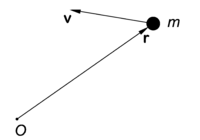Angular momentum (classical)
In physics, angular momentum is a kinematic property of one or more point masses. Its importance derives from the fact that it is a conserved quantity in several physical circumstances. (Recall that a conserved quantity of a physical system is a property that does not change over time.)
The angular momentum of a single point mass m is defined with respect to a point O. Denote the vector from O to m by r (see the figure). Let the mass have velocity v, then the angular momentum L of the point mass is the cross product,
It follows from the definition of cross product that the vector L is perpendicular to the plane of the figure and points towards the reader. Note that the definition p ≡ m v for the linear momentum is introduced here.
The definition of the angular momentum of a system of n point masses is the following simple generalization:


